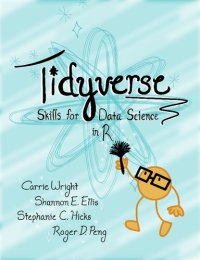
Ebook: Tidyverse Skills for Data Science in R
- Genre: Computers // Programming: Programming Languages
- Year: 2021
- Publisher: Leanpub
- Language: English
- pdf
Develop insights from data with tidy tools. Import, wrangle, visualize, and model data with the Tidyverse R packages.
This book is intended for data scientists with some familiarity with the R programming language who are seeking to do Data Science using the Tidyverse family of packages. Through 5 chapters, you will cover importing, wrangling, visualizing, and modeling data using the powerful Tidyverse packages, including the new Tidymodels framework. The Tidyverse packages provide a simple but powerful approach to Data Science which scales from the most basic analyses to massive data deployments. This book covers the entire life cycle of a Data Science project and presents specific tidy tools for each stage.
This course introduces a powerful set of Data Science tools known as the Tidyverse. The Tidyverse has revolutionized the way in which data scientists do almost every aspect of their job. We will cover the simple idea of “tidy data” and how this idea serves to organize data for analysis and modeling. We will also cover how non-tidy data can be transformed to tidy data, the Data Science project life cycle, and the ecosystem of Tidyverse R packages that can be used to execute a Data Science project.
Functional programming is an approach to programming in which the code evaluated is treated as a mathematical function. It is declarative, so expressions (or declarations) are used instead of statements. Functional programming is often touted and used due to the fact that cleaner, shorter code can be written. In this shorter code, functional programming allows for code that is elegant but also understandable. Ultimately, the goal is to have simpler code that minimizes time required for debugging, testing, and maintaining.
R at its core is a functional programming language. If you’re familiar with the apply() family of functions in base R, you’ve carried out some functional programming! Here, we’ll discuss functional programming and utilize the purrr package, designed to enhance functional programming in R. By utilizing functional programming, you’ll be able to minimize redundancy within your code. The way this happens in reality is by determining what small building blocks your code needs. These will each be a function. These small building block functions are then combined into more complex structures to be your final program.
This book is intended for data scientists with some familiarity with the R programming language who are seeking to do Data Science using the Tidyverse family of packages. Through 5 chapters, you will cover importing, wrangling, visualizing, and modeling data using the powerful Tidyverse packages, including the new Tidymodels framework. The Tidyverse packages provide a simple but powerful approach to Data Science which scales from the most basic analyses to massive data deployments. This book covers the entire life cycle of a Data Science project and presents specific tidy tools for each stage.
This course introduces a powerful set of Data Science tools known as the Tidyverse. The Tidyverse has revolutionized the way in which data scientists do almost every aspect of their job. We will cover the simple idea of “tidy data” and how this idea serves to organize data for analysis and modeling. We will also cover how non-tidy data can be transformed to tidy data, the Data Science project life cycle, and the ecosystem of Tidyverse R packages that can be used to execute a Data Science project.
Functional programming is an approach to programming in which the code evaluated is treated as a mathematical function. It is declarative, so expressions (or declarations) are used instead of statements. Functional programming is often touted and used due to the fact that cleaner, shorter code can be written. In this shorter code, functional programming allows for code that is elegant but also understandable. Ultimately, the goal is to have simpler code that minimizes time required for debugging, testing, and maintaining.
R at its core is a functional programming language. If you’re familiar with the apply() family of functions in base R, you’ve carried out some functional programming! Here, we’ll discuss functional programming and utilize the purrr package, designed to enhance functional programming in R. By utilizing functional programming, you’ll be able to minimize redundancy within your code. The way this happens in reality is by determining what small building blocks your code needs. These will each be a function. These small building block functions are then combined into more complex structures to be your final program.
Download the book Tidyverse Skills for Data Science in R for free or read online
Continue reading on any device:

Last viewed books
Related books
{related-news}
Comments (0)